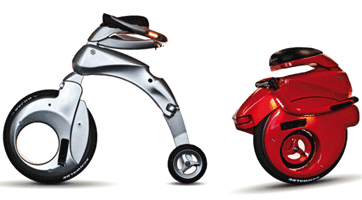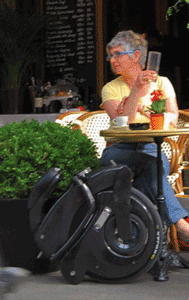
YikeBike spells urban freedom
Amid growing concern about climate change and urban congestion, electric bicycles or e-bikes, once a curiosity, are becoming an increasingly popular urban transport choice. In just a decade, the e-bike business has become a US$11 billion global industry with enormous potential for further growth. While many e-bikes are similar to a standard bicycle with pedals, a group of engineers from New Zealand have come up with a radically different design that is turning heads and capturing the imagination of urban travelers. Featured in TIME Magazine as one of the world’s top inventions in 2009 and winner of countless design awards, the mini-farthing, a zippy and versatile new urban transport solution, features in Guinness World Records as the most compact electric bike in the world. The mini-farthing promises to transform the urban transport experience, offering city dwellers a fast, safe and easy way to navigate the urban environment.

Light, easy to fold and highly portable, the YikeBike™ can link up with any other
form of urban transport. (Photos: Yikebike Limited)
Basic bicycle design has remained relatively unchanged for the past 125 years. The mini-farthing, commercialized as the YikeBike, has a radically different riding position and steering and wheel configuration. The result of five years of research and development, the YikeBike is light and extremely small when folded, making it easy to carry and store and eliminating parking problems and the risk of theft. The mini-farthing is made from ultra-light carbon fiber and encompasses state-of-the-art technology, engineering and industrial design to create a new class of bicycle, like a mountain, road or racing bike.
Inspired by Dean Kamen’s revolutionary transport device, the Segway (see box), Grant Ryan, inventor of the mini-farthing and co-founder of YikeBike which markets the device, told WIPO Magazine the project’s goal “was to design something that could become the most common transport device in the world.” This, he said, was “so bold as to be literally crazy”, because the traditional bicycle is still the most commonly owned form of transport in the world, with over 120 million sold each year.
The original team of three, however, remained undeterred, recognizing the need for an effective urban transport alternative to the gridlock facing city commuters around the world. “We thought if you could take a bike and make it fundamentally smaller so that you didn’t need to leave it outside, and if you had something that could go as fast as cars in a congested city – the average speed is already down to around 15 km/h - that would be a great solution.” Mr. Ryan explained, “the great thing about it is that you don’t have to change a city for it to work by installing charge stations all over the place; you can use the billion or so charge ports that are already installed around the world, and it only takes around 8 cents worth of electricity to charge.” It allows riders to see and be seen, is highly portable and can link up with any other form of transport.
Acting on a hunch
From a young age, Grant Ryan wanted to be an inventor. He said, “I spent a lot of time thinking I needed to be creative and tried lots of different things. Lying on the couch works for me,” he confessed; “people might think that’s lazy, but today everyone is so busy they don’t give themselves time to relax and think.” He said that he no longer “talks about good ideas any more … because, as an inventor, you don’t really come up with an idea; you have a hunch and then there’s a process of rapid prototyping – trying lots of things is really the only way you can come up with something.”
“We are strong believers in rapid prototyping and designed our early models so that we could rapidly test lots of configurations,” Mr. Ryan explained. “We knew we needed to have a decent-sized front wheel to start to manage the bumps” he noted, “and then we just wanted to make everything else as small as possible.” At first, he said, “we didn’t know how we were going to steer the bike – if it was going to be up and down or a joystick.”
Through a process of trial and error the team made steady progress. “We would try something, tweak it, try it again, change it and try it again. Now we cringe at some of the developments, but that’s the nature of process - it really is a good development process,” he said. “We were not sure that there was another configuration as stable and easy to ride as the modern bicycle, but after years of applying basic principles of engineering and trial and error we have discovered a new and dramatically smaller one.”

YikeBike™ Inventor Craig Ryan with the most compact electric bike in the world.
A fast, safe and easy way to navigate the urban environment.
“The reason we went electric,” Mr. Ryan explained, “was because, ultimately, it allowed us to make the bike smaller, lighter and more efficient.” The bike comes with a whole range of safety features, including lights, and “is the first bike in the world with electronic anti-skid brakes.” It is designed to go anywhere a standard bike goes, can handle potholes with ease and allows riders to see traffic and be seen.
One of the challenges the company faced in bringing the YikeBike to market was overcoming the deep-rooted perception that there is something inherently natural about leaning forward onto handlebars when riding a standard bike. At first, riders found the YikeBike’s upright position “undignified,” “inefficient”, “complicated” – in sum, “a bit too weird,” but then they really liked it.
Grant Ryan has no doubt that the inventors of the original bicycle encountered a similar reaction when they came up with its design. He said, “One of the things we have observed is that new things are always really weird for people.” This, he said was where early technology adopters, whom he considered “unappreciated economic superheroes”, played a key role.
Early adopters take a chance on something new and, for Grant Ryan, “the only way that small companies can get cracking in creating new innovative products is if there are enough early adopters to give it a go.” This, he explains, “allows companies to raise the capital and to produce a new product at low cost so that everyone can have it.” By way of illustration, he pointed to the early adopters of the first “brick-like” cell phones. “But for early adopters, we would not have benefitted from these technologies,” he contended.
| Specifications |
|---|
|
Range: 10 km and up to 30 km with additional battery packs Top speed: 23 km/h Wheel size: 50.8 cms (20-inch) front and 20.3 cms (8-inch) back Weight: 10.8 kilograms |

New Zealand business commentator Rod Oram, one of YikeBike’s first customers, said that it gives “a wonderful sense of freedom and it is very maneuverable and looks gorgeous. The ultra-light electric bike is not only genius for speeding between meetings, but folds up in a shoulder bag in just under 20 seconds. It is amazingly light and foldable and therefore very easy to transport,” he said.
Grant Ryan and his team are keenly aware of the importance of intellectual property (IP) and began thinking about protecting their innovation in the early stages of its development. Mr. Ryan is “strongly focused” on IP and believes it is “very, very important.” He notes that, as an inventor, he holds a number of other patents and that “the patent people I work with loved the idea [of the YikeBike] so much they became shareholders.” He has recently sought international protection for this groundbreaking innovation via WIPO’s Patent Cooperation Treaty (PCT) (WO/2010/007516). “I am a huge fan of the PCT system. It’s a fantastic development that helps stimulate investments that move technology forward,” he said.
The company believes the YikeBike offers a “unique combination of stable and safe riding, compact size and light weight.” Having acquired a robust portfolio of patents, the company is now seeking to license its technology to other creative manufacturing companies. It offers “time-limited exclusive licenses for particular markets and types of implementation” to allow other companies to establish brand leadership in a given market. “It makes little sense that we are the sole producers of the YikeBike when others can also build a successful business around it,” Mr. Ryan mused.
When we asked him what new projects he was working on, he commented, “they are too secret to say – having fun with the YikeBike at present – there will be more though.”
| The Segway® Human Transporter |
|---|
|
The Segway HT, unveiled by its inventor Dean Kamen in 2001, is a self-balancing electric transportation device controlled by the natural movement of the rider. It features a sophisticated combination of gyroscopes, computers, and propulsion and energy management systems that sense the changing terrain and the rider’s body position 100 times per second. “If there’s a feeling you get when trying a Segway product, it’s like it can almost read your mind. It’s not magic. It’s the combination of propulsion, energy, inertial sensing and an incredibly intuitive user interface,” the company website notes. International patent protection was sought for the Segway through WIPO’s PCT (WO00/75001). |
CJ
The WIPO Magazine is intended to help broaden public understanding of intellectual property and of WIPO’s work, and is not an official document of WIPO. The designations employed and the presentation of material throughout this publication do not imply the expression of any opinion whatsoever on the part of WIPO concerning the legal status of any country, territory or area or of its authorities, or concerning the delimitation of its frontiers or boundaries. This publication is not intended to reflect the views of the Member States or the WIPO Secretariat. The mention of specific companies or products of manufacturers does not imply that they are endorsed or recommended by WIPO in preference to others of a similar nature that are not mentioned.